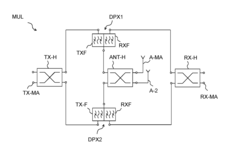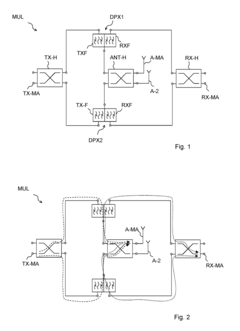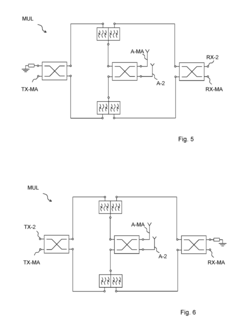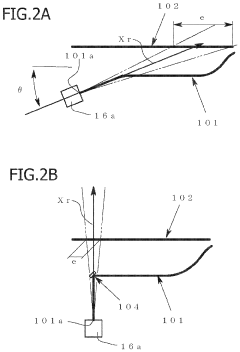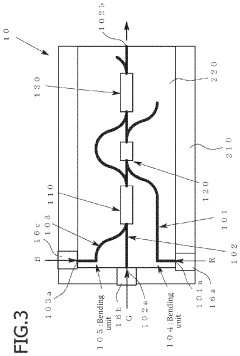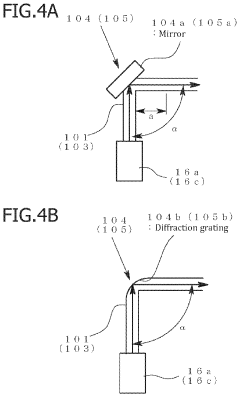Cutting-Edge Multiplexer Applications in Emerging Technologies
JUL 13, 20259 MIN READ
Generate Your Research Report Instantly with AI Agent
Patsnap Eureka helps you evaluate technical feasibility & market potential.
Multiplexer Evolution
Multiplexers have undergone significant evolution since their inception, transforming from simple signal-combining devices to sophisticated components integral to modern communication and data processing systems. The journey of multiplexer technology can be traced through several key developmental stages, each marked by groundbreaking innovations and expanding applications.
In the early days of telecommunications, multiplexers were primarily used for combining multiple low-speed analog signals into a single high-speed transmission. This basic time-division multiplexing (TDM) technique laid the foundation for more advanced multiplexing technologies. As digital communications emerged, multiplexers adapted to handle digital signals, leading to the development of digital time-division multiplexing (DTDM) systems in the 1960s and 1970s.
The advent of fiber-optic communications in the 1980s brought about a revolution in multiplexing technology. Wavelength-division multiplexing (WDM) emerged as a powerful technique for dramatically increasing the capacity of optical fiber networks. This technology allowed multiple optical signals to be transmitted simultaneously over a single fiber by using different wavelengths of light.
The 1990s and early 2000s saw the rapid advancement of dense wavelength-division multiplexing (DWDM) systems, capable of multiplexing hundreds of wavelengths onto a single fiber. This development played a crucial role in meeting the exponential growth in bandwidth demand driven by the internet boom.
Parallel to optical multiplexing advancements, electronic multiplexing techniques continued to evolve. The rise of digital signal processing (DSP) enabled more sophisticated multiplexing schemes, such as orthogonal frequency-division multiplexing (OFDM), which became fundamental to wireless communication standards like 4G LTE.
In recent years, the evolution of multiplexers has been driven by the demands of emerging technologies such as 5G networks, Internet of Things (IoT), and high-performance computing. Advanced multiplexing techniques like massive MIMO (Multiple-Input Multiple-Output) have become essential for 5G's high-bandwidth, low-latency requirements.
The ongoing development of quantum communication systems is pushing multiplexer technology into new frontiers. Quantum multiplexing techniques are being explored to enable the simultaneous transmission of multiple qubits, potentially revolutionizing secure communication and quantum computing.
As we look to the future, multiplexer evolution is likely to continue in directions that support higher data rates, lower power consumption, and increased integration with other system components. The convergence of photonics and electronics in silicon photonics platforms promises to deliver highly integrated multiplexing solutions for next-generation data centers and communication networks.
In the early days of telecommunications, multiplexers were primarily used for combining multiple low-speed analog signals into a single high-speed transmission. This basic time-division multiplexing (TDM) technique laid the foundation for more advanced multiplexing technologies. As digital communications emerged, multiplexers adapted to handle digital signals, leading to the development of digital time-division multiplexing (DTDM) systems in the 1960s and 1970s.
The advent of fiber-optic communications in the 1980s brought about a revolution in multiplexing technology. Wavelength-division multiplexing (WDM) emerged as a powerful technique for dramatically increasing the capacity of optical fiber networks. This technology allowed multiple optical signals to be transmitted simultaneously over a single fiber by using different wavelengths of light.
The 1990s and early 2000s saw the rapid advancement of dense wavelength-division multiplexing (DWDM) systems, capable of multiplexing hundreds of wavelengths onto a single fiber. This development played a crucial role in meeting the exponential growth in bandwidth demand driven by the internet boom.
Parallel to optical multiplexing advancements, electronic multiplexing techniques continued to evolve. The rise of digital signal processing (DSP) enabled more sophisticated multiplexing schemes, such as orthogonal frequency-division multiplexing (OFDM), which became fundamental to wireless communication standards like 4G LTE.
In recent years, the evolution of multiplexers has been driven by the demands of emerging technologies such as 5G networks, Internet of Things (IoT), and high-performance computing. Advanced multiplexing techniques like massive MIMO (Multiple-Input Multiple-Output) have become essential for 5G's high-bandwidth, low-latency requirements.
The ongoing development of quantum communication systems is pushing multiplexer technology into new frontiers. Quantum multiplexing techniques are being explored to enable the simultaneous transmission of multiple qubits, potentially revolutionizing secure communication and quantum computing.
As we look to the future, multiplexer evolution is likely to continue in directions that support higher data rates, lower power consumption, and increased integration with other system components. The convergence of photonics and electronics in silicon photonics platforms promises to deliver highly integrated multiplexing solutions for next-generation data centers and communication networks.
Market Demand Analysis
The market demand for cutting-edge multiplexer applications in emerging technologies has been experiencing significant growth, driven by the increasing need for efficient data transmission and processing across various sectors. Telecommunications, data centers, and high-performance computing industries are at the forefront of this demand, as they seek to maximize bandwidth utilization and minimize latency in their operations.
In the telecommunications sector, the rollout of 5G networks has created a surge in demand for advanced multiplexing solutions. These networks require sophisticated multiplexers to handle the massive increase in data traffic and to support the ultra-low latency requirements of emerging applications such as autonomous vehicles and remote surgery. The market for 5G-compatible multiplexers is expected to grow substantially over the next five years as network operators continue to expand their infrastructure.
Data centers are another key driver of multiplexer demand, as they strive to optimize their network architectures to handle the exponential growth in cloud computing and big data analytics. The need for higher data transmission speeds and improved energy efficiency has led to increased adoption of wavelength division multiplexing (WDM) technologies, which allow for multiple data streams to be transmitted simultaneously over a single optical fiber.
The rise of edge computing and the Internet of Things (IoT) has also contributed to the growing market for multiplexers. As more devices become connected and generate vast amounts of data, there is a pressing need for efficient data aggregation and transmission at the network edge. Multiplexers play a crucial role in this ecosystem by enabling the consolidation of multiple data streams from various IoT devices before transmission to central processing units.
In the automotive industry, the development of advanced driver assistance systems (ADAS) and autonomous vehicles has created a new market for high-speed, low-latency multiplexers. These systems require real-time processing of data from multiple sensors, cameras, and radar units, necessitating robust multiplexing solutions to manage the complex data flows within vehicles.
The aerospace and defense sectors are also driving demand for cutting-edge multiplexers, particularly in satellite communications and radar systems. As these applications require increasingly sophisticated signal processing capabilities, the market for specialized multiplexers tailored to these high-performance environments continues to expand.
Looking ahead, the market for multiplexer applications is poised for continued growth as emerging technologies such as artificial intelligence, machine learning, and quantum computing create new demands for data processing and transmission capabilities. The integration of multiplexers with software-defined networking (SDN) and network function virtualization (NFV) technologies is expected to open up new opportunities for innovation and market expansion in the coming years.
In the telecommunications sector, the rollout of 5G networks has created a surge in demand for advanced multiplexing solutions. These networks require sophisticated multiplexers to handle the massive increase in data traffic and to support the ultra-low latency requirements of emerging applications such as autonomous vehicles and remote surgery. The market for 5G-compatible multiplexers is expected to grow substantially over the next five years as network operators continue to expand their infrastructure.
Data centers are another key driver of multiplexer demand, as they strive to optimize their network architectures to handle the exponential growth in cloud computing and big data analytics. The need for higher data transmission speeds and improved energy efficiency has led to increased adoption of wavelength division multiplexing (WDM) technologies, which allow for multiple data streams to be transmitted simultaneously over a single optical fiber.
The rise of edge computing and the Internet of Things (IoT) has also contributed to the growing market for multiplexers. As more devices become connected and generate vast amounts of data, there is a pressing need for efficient data aggregation and transmission at the network edge. Multiplexers play a crucial role in this ecosystem by enabling the consolidation of multiple data streams from various IoT devices before transmission to central processing units.
In the automotive industry, the development of advanced driver assistance systems (ADAS) and autonomous vehicles has created a new market for high-speed, low-latency multiplexers. These systems require real-time processing of data from multiple sensors, cameras, and radar units, necessitating robust multiplexing solutions to manage the complex data flows within vehicles.
The aerospace and defense sectors are also driving demand for cutting-edge multiplexers, particularly in satellite communications and radar systems. As these applications require increasingly sophisticated signal processing capabilities, the market for specialized multiplexers tailored to these high-performance environments continues to expand.
Looking ahead, the market for multiplexer applications is poised for continued growth as emerging technologies such as artificial intelligence, machine learning, and quantum computing create new demands for data processing and transmission capabilities. The integration of multiplexers with software-defined networking (SDN) and network function virtualization (NFV) technologies is expected to open up new opportunities for innovation and market expansion in the coming years.
Technical Challenges
Multiplexers play a crucial role in emerging technologies, but their implementation faces several technical challenges. One of the primary obstacles is the increasing demand for higher data rates and bandwidth in modern communication systems. As technologies like 5G, IoT, and autonomous vehicles continue to evolve, multiplexers must handle exponentially growing volumes of data while maintaining signal integrity and minimizing latency.
The miniaturization of devices presents another significant challenge. As electronic components become smaller and more compact, designing multiplexers that can fit into these confined spaces while still delivering optimal performance becomes increasingly difficult. This miniaturization also leads to issues related to heat dissipation and power consumption, which must be carefully managed to ensure reliable operation.
Signal interference and crosstalk pose substantial challenges in multiplexer design, particularly in high-frequency applications. As the density of components increases and signal frequencies rise, maintaining signal isolation and preventing unwanted interactions between channels becomes more complex. This issue is especially critical in applications such as radar systems and satellite communications, where signal purity is paramount.
The need for flexibility and reconfigurability in multiplexer systems adds another layer of complexity. Many emerging technologies require adaptive systems that can dynamically adjust to changing conditions or requirements. Developing multiplexers that can be easily reconfigured or tuned without compromising performance or reliability is a significant technical hurdle.
Power efficiency is a growing concern, particularly in battery-powered devices and energy-conscious applications. Designing multiplexers that can operate efficiently across a wide range of frequencies and power levels, while minimizing energy consumption, remains a challenging task. This challenge is compounded by the need to maintain performance in increasingly harsh or variable environmental conditions.
The integration of multiplexers with other system components, such as antennas, amplifiers, and digital signal processors, presents its own set of challenges. Ensuring seamless interoperability and optimizing overall system performance requires careful consideration of interface designs and signal processing techniques. This integration becomes even more complex when dealing with heterogeneous systems that combine different technologies or communication standards.
Lastly, the rapid pace of technological advancement in fields like quantum computing and terahertz communications is pushing the boundaries of traditional multiplexer design. Developing multiplexers capable of operating at these extreme frequencies or in quantum environments requires innovative approaches and materials, often pushing the limits of current manufacturing capabilities and theoretical understanding.
The miniaturization of devices presents another significant challenge. As electronic components become smaller and more compact, designing multiplexers that can fit into these confined spaces while still delivering optimal performance becomes increasingly difficult. This miniaturization also leads to issues related to heat dissipation and power consumption, which must be carefully managed to ensure reliable operation.
Signal interference and crosstalk pose substantial challenges in multiplexer design, particularly in high-frequency applications. As the density of components increases and signal frequencies rise, maintaining signal isolation and preventing unwanted interactions between channels becomes more complex. This issue is especially critical in applications such as radar systems and satellite communications, where signal purity is paramount.
The need for flexibility and reconfigurability in multiplexer systems adds another layer of complexity. Many emerging technologies require adaptive systems that can dynamically adjust to changing conditions or requirements. Developing multiplexers that can be easily reconfigured or tuned without compromising performance or reliability is a significant technical hurdle.
Power efficiency is a growing concern, particularly in battery-powered devices and energy-conscious applications. Designing multiplexers that can operate efficiently across a wide range of frequencies and power levels, while minimizing energy consumption, remains a challenging task. This challenge is compounded by the need to maintain performance in increasingly harsh or variable environmental conditions.
The integration of multiplexers with other system components, such as antennas, amplifiers, and digital signal processors, presents its own set of challenges. Ensuring seamless interoperability and optimizing overall system performance requires careful consideration of interface designs and signal processing techniques. This integration becomes even more complex when dealing with heterogeneous systems that combine different technologies or communication standards.
Lastly, the rapid pace of technological advancement in fields like quantum computing and terahertz communications is pushing the boundaries of traditional multiplexer design. Developing multiplexers capable of operating at these extreme frequencies or in quantum environments requires innovative approaches and materials, often pushing the limits of current manufacturing capabilities and theoretical understanding.
Current Solutions
01 Optical multiplexing systems
Optical multiplexers are used in fiber optic communication systems to combine multiple optical signals into a single fiber. These systems often involve wavelength division multiplexing (WDM) techniques to increase data transmission capacity. Advanced optical multiplexers may incorporate tunable lasers, optical switches, and signal processing components to optimize performance and flexibility.- Optical multiplexing systems: Optical multiplexers are used in fiber optic communication systems to combine multiple optical signals into a single fiber. These systems often employ wavelength division multiplexing (WDM) to increase data transmission capacity. Advanced optical multiplexers may incorporate tunable filters, optical switches, and signal amplification techniques to enhance performance and flexibility.
- Digital multiplexers for data communication: Digital multiplexers are crucial components in data communication networks, allowing multiple data streams to be combined and transmitted over a single channel. These devices often implement time division multiplexing (TDM) techniques and may include features such as data compression, error correction, and adaptive bandwidth allocation to optimize network performance.
- Multiplexers in wireless communication systems: Multiplexers play a vital role in wireless communication systems, enabling efficient use of radio frequency spectrum. These multiplexers may incorporate advanced signal processing techniques, such as orthogonal frequency-division multiplexing (OFDM), and adaptive modulation schemes to improve spectral efficiency and combat interference in mobile networks.
- Analog multiplexers for signal processing: Analog multiplexers are used in various signal processing applications, including data acquisition systems, sensor interfaces, and audio/video equipment. These devices often feature low-noise designs, high-speed switching capabilities, and precision signal routing to maintain signal integrity across multiple channels.
- Multiplexers in display technologies: Multiplexers are essential components in modern display technologies, such as LCD and OLED panels. They are used to control pixel addressing, manage refresh rates, and implement various display driving schemes. Advanced multiplexer designs in this field focus on reducing power consumption, improving response times, and enhancing image quality.
02 Digital multiplexers for data communication
Digital multiplexers are essential components in data communication systems, allowing multiple data streams to be combined and transmitted over a single channel. These devices often incorporate time division multiplexing (TDM) techniques, error correction mechanisms, and advanced signal processing algorithms to ensure efficient and reliable data transmission. Modern digital multiplexers may also support various communication protocols and interfaces.Expand Specific Solutions03 Multiplexers in wireless communication systems
Multiplexers play a crucial role in wireless communication systems, enabling efficient use of radio frequency spectrum and supporting multiple users or services. These multiplexers often incorporate advanced signal processing techniques, such as orthogonal frequency-division multiplexing (OFDM) and multiple-input multiple-output (MIMO) technologies. They may also include adaptive algorithms to optimize performance in varying channel conditions.Expand Specific Solutions04 Analog multiplexers and switching circuits
Analog multiplexers are used in various electronic systems to switch between multiple analog input signals. These devices often incorporate high-speed switching elements, low-noise amplifiers, and precision control circuits to maintain signal integrity. Advanced analog multiplexers may also include features such as programmable gain, bandwidth control, and built-in calibration mechanisms to enhance performance in demanding applications.Expand Specific Solutions05 Multiplexers in computing and data processing systems
Multiplexers are essential components in computing and data processing systems, enabling efficient data routing and resource sharing. These multiplexers often incorporate advanced logic circuits, high-speed interfaces, and sophisticated control mechanisms to optimize system performance. They may also include features such as error detection and correction, power management, and compatibility with various bus protocols to meet the demands of modern computing architectures.Expand Specific Solutions
Industry Leaders
The market for cutting-edge multiplexer applications in emerging technologies is in a growth phase, with increasing demand driven by advancements in telecommunications, data centers, and 5G networks. The global market size is projected to expand significantly over the next few years, fueled by the need for higher bandwidth and more efficient data transmission. In terms of technological maturity, companies like NTT, Ericsson, and Huawei are leading the way with innovative solutions, while others such as NEC, Samsung, and Fujitsu are also making significant contributions. The competitive landscape is characterized by intense R&D efforts and strategic partnerships, as firms strive to develop more advanced and cost-effective multiplexer technologies to meet the evolving needs of various industries.
Telefonaktiebolaget LM Ericsson
Technical Solution: Ericsson has made significant strides in multiplexer technology for next-generation wireless networks. Their approach focuses on advanced time-division multiplexing (TDM) and wavelength-division multiplexing (WDM) techniques for 5G and beyond. Ericsson's multiplexers leverage machine learning algorithms to optimize channel allocation and reduce interference in dense network environments[2]. The company has also developed innovative frequency-division multiplexing (FDM) solutions that enable efficient spectrum sharing between multiple operators[4]. Ericsson's multiplexers incorporate software-defined networking (SDN) principles, allowing for flexible and programmable network configurations that can adapt to changing traffic patterns and service requirements[6].
Strengths: Extensive experience in telecommunications infrastructure, strong partnerships with global operators, and a comprehensive portfolio of network solutions. Weaknesses: Intense competition in the 5G market and potential challenges in maintaining technological leadership.
NEC Corp.
Technical Solution: NEC has developed cutting-edge multiplexer technologies for both wireless and optical communications. Their focus is on high-capacity, low-latency solutions for 5G and beyond. NEC's multiplexers utilize advanced digital signal processing techniques to achieve spectral efficiencies of up to 6 bits/s/Hz in mobile networks[7]. In optical communications, NEC has pioneered the use of space-division multiplexing (SDM) in conjunction with WDM, enabling transmission capacities exceeding 1 Pb/s over a single fiber[9]. The company has also introduced AI-driven multiplexers that can dynamically adjust modulation schemes and power levels to optimize network performance and energy efficiency[11].
Strengths: Strong presence in both wireless and optical communications, expertise in AI and machine learning integration, and a history of innovation in network technologies. Weaknesses: Relatively smaller market share compared to some competitors and potential challenges in scaling global operations.
Key Innovations
Multiplexer and mobile communication device comprising a multiplexer
PatentActiveUS20170077986A1
Innovation
- A multiplexer design comprising two duplexers and three hybrids, where each duplexer is electrically connected in parallel to the hybrids, allowing for phase shifting and tunability, enabling simultaneous signal transfer in multiple paths without the need for additional filters or switches, thus maintaining superior isolation and compactness.
multiplexer
PatentActiveUS20200348467A1
Innovation
- The multiplexer design incorporates an inclined optical axis for laser beam sources and uses bending units to redirect light paths, allowing for closer waveguide placement while minimizing stray light by adjusting the angle of inclination and utilizing bending units like diffraction gratings or mirrors to manage light paths effectively.
Standardization Efforts
Standardization efforts in the field of cutting-edge multiplexer applications for emerging technologies have become increasingly crucial as these technologies continue to evolve and expand their reach. Industry stakeholders, including manufacturers, service providers, and regulatory bodies, have recognized the need for unified standards to ensure interoperability, reliability, and performance consistency across various platforms and applications.
Several international organizations have taken the lead in developing and promoting standardization initiatives for multiplexer technologies. The International Telecommunication Union (ITU) has been at the forefront, establishing working groups dedicated to defining specifications for next-generation multiplexing systems. These efforts have resulted in a series of recommendations that address key aspects such as signal quality, bandwidth allocation, and error correction mechanisms.
In parallel, the Institute of Electrical and Electronics Engineers (IEEE) has been actively working on standards for multiplexer applications in emerging fields such as 5G networks, Internet of Things (IoT), and edge computing. Their focus has been on creating guidelines for integrating multiplexer technologies with software-defined networking (SDN) and network function virtualization (NFV) architectures, enabling more flexible and efficient network management.
The European Telecommunications Standards Institute (ETSI) has also contributed significantly to the standardization landscape. Their efforts have centered on developing specifications for multiplexer applications in areas like smart cities, autonomous vehicles, and industrial automation. These standards aim to ensure seamless communication and data exchange between diverse systems and devices operating in complex, interconnected environments.
Collaboration between industry consortia and standards bodies has been instrumental in driving standardization efforts forward. Organizations like the Open Networking Foundation (ONF) and the Telecommunications Industry Association (TIA) have been working closely with technology providers to develop open standards and reference architectures for multiplexer implementations in software-defined and virtualized network environments.
One of the key challenges in standardization efforts has been addressing the diverse requirements of different emerging technologies. To tackle this, working groups have adopted a modular approach, developing core standards that can be extended or customized for specific applications. This flexibility allows for the creation of industry-specific profiles while maintaining a common foundation for interoperability.
As multiplexer technologies continue to advance, standardization efforts are also focusing on future-proofing specifications. This includes provisions for scalability, support for higher data rates, and integration with emerging paradigms such as quantum communication and artificial intelligence-driven network optimization. By anticipating future technological developments, these standards aim to provide a stable foundation for long-term innovation and investment in multiplexer applications.
Several international organizations have taken the lead in developing and promoting standardization initiatives for multiplexer technologies. The International Telecommunication Union (ITU) has been at the forefront, establishing working groups dedicated to defining specifications for next-generation multiplexing systems. These efforts have resulted in a series of recommendations that address key aspects such as signal quality, bandwidth allocation, and error correction mechanisms.
In parallel, the Institute of Electrical and Electronics Engineers (IEEE) has been actively working on standards for multiplexer applications in emerging fields such as 5G networks, Internet of Things (IoT), and edge computing. Their focus has been on creating guidelines for integrating multiplexer technologies with software-defined networking (SDN) and network function virtualization (NFV) architectures, enabling more flexible and efficient network management.
The European Telecommunications Standards Institute (ETSI) has also contributed significantly to the standardization landscape. Their efforts have centered on developing specifications for multiplexer applications in areas like smart cities, autonomous vehicles, and industrial automation. These standards aim to ensure seamless communication and data exchange between diverse systems and devices operating in complex, interconnected environments.
Collaboration between industry consortia and standards bodies has been instrumental in driving standardization efforts forward. Organizations like the Open Networking Foundation (ONF) and the Telecommunications Industry Association (TIA) have been working closely with technology providers to develop open standards and reference architectures for multiplexer implementations in software-defined and virtualized network environments.
One of the key challenges in standardization efforts has been addressing the diverse requirements of different emerging technologies. To tackle this, working groups have adopted a modular approach, developing core standards that can be extended or customized for specific applications. This flexibility allows for the creation of industry-specific profiles while maintaining a common foundation for interoperability.
As multiplexer technologies continue to advance, standardization efforts are also focusing on future-proofing specifications. This includes provisions for scalability, support for higher data rates, and integration with emerging paradigms such as quantum communication and artificial intelligence-driven network optimization. By anticipating future technological developments, these standards aim to provide a stable foundation for long-term innovation and investment in multiplexer applications.
Energy Efficiency
Energy efficiency is a critical consideration in the development and application of cutting-edge multiplexers in emerging technologies. As these devices become increasingly integral to advanced communication systems, data centers, and high-performance computing environments, their energy consumption has a significant impact on overall system performance and operational costs.
Modern multiplexers are designed with a focus on minimizing power consumption while maximizing data throughput. This is achieved through various innovative approaches, including the use of advanced semiconductor materials and optimized circuit designs. For instance, the integration of low-power CMOS technology has enabled the creation of multiplexers that operate at high speeds with reduced energy requirements.
One of the key strategies for improving energy efficiency in multiplexers is the implementation of dynamic power management techniques. These systems can adaptively adjust power consumption based on real-time traffic demands, effectively reducing energy waste during periods of low utilization. Additionally, the incorporation of sleep modes and rapid wake-up capabilities allows multiplexers to conserve energy when not actively processing data.
The development of energy-efficient multiplexers has also led to advancements in thermal management. By reducing power consumption, these devices generate less heat, which in turn decreases the cooling requirements for the overall system. This cascading effect results in substantial energy savings, particularly in large-scale deployments such as telecommunications networks and cloud computing infrastructures.
In the context of emerging technologies, such as 5G and beyond, energy-efficient multiplexers play a crucial role in enabling the dense deployment of small cells and massive MIMO systems. These applications demand high-performance multiplexing with minimal power overhead to support the increased network capacity and coverage requirements.
Furthermore, the push towards green computing and sustainable technology has driven research into novel materials and architectures for multiplexers. For example, the exploration of photonic integrated circuits for optical multiplexing offers the potential for ultra-low power operation at extremely high data rates, potentially revolutionizing the energy efficiency landscape of data transmission systems.
As the demand for data-intensive applications continues to grow, the importance of energy-efficient multiplexers in emerging technologies cannot be overstated. Their ability to handle increasing data volumes while minimizing energy consumption is essential for the sustainable growth of digital infrastructure and the realization of next-generation communication and computing paradigms.
Modern multiplexers are designed with a focus on minimizing power consumption while maximizing data throughput. This is achieved through various innovative approaches, including the use of advanced semiconductor materials and optimized circuit designs. For instance, the integration of low-power CMOS technology has enabled the creation of multiplexers that operate at high speeds with reduced energy requirements.
One of the key strategies for improving energy efficiency in multiplexers is the implementation of dynamic power management techniques. These systems can adaptively adjust power consumption based on real-time traffic demands, effectively reducing energy waste during periods of low utilization. Additionally, the incorporation of sleep modes and rapid wake-up capabilities allows multiplexers to conserve energy when not actively processing data.
The development of energy-efficient multiplexers has also led to advancements in thermal management. By reducing power consumption, these devices generate less heat, which in turn decreases the cooling requirements for the overall system. This cascading effect results in substantial energy savings, particularly in large-scale deployments such as telecommunications networks and cloud computing infrastructures.
In the context of emerging technologies, such as 5G and beyond, energy-efficient multiplexers play a crucial role in enabling the dense deployment of small cells and massive MIMO systems. These applications demand high-performance multiplexing with minimal power overhead to support the increased network capacity and coverage requirements.
Furthermore, the push towards green computing and sustainable technology has driven research into novel materials and architectures for multiplexers. For example, the exploration of photonic integrated circuits for optical multiplexing offers the potential for ultra-low power operation at extremely high data rates, potentially revolutionizing the energy efficiency landscape of data transmission systems.
As the demand for data-intensive applications continues to grow, the importance of energy-efficient multiplexers in emerging technologies cannot be overstated. Their ability to handle increasing data volumes while minimizing energy consumption is essential for the sustainable growth of digital infrastructure and the realization of next-generation communication and computing paradigms.
Unlock deeper insights with Patsnap Eureka Quick Research — get a full tech report to explore trends and direct your research. Try now!
Generate Your Research Report Instantly with AI Agent
Supercharge your innovation with Patsnap Eureka AI Agent Platform!
